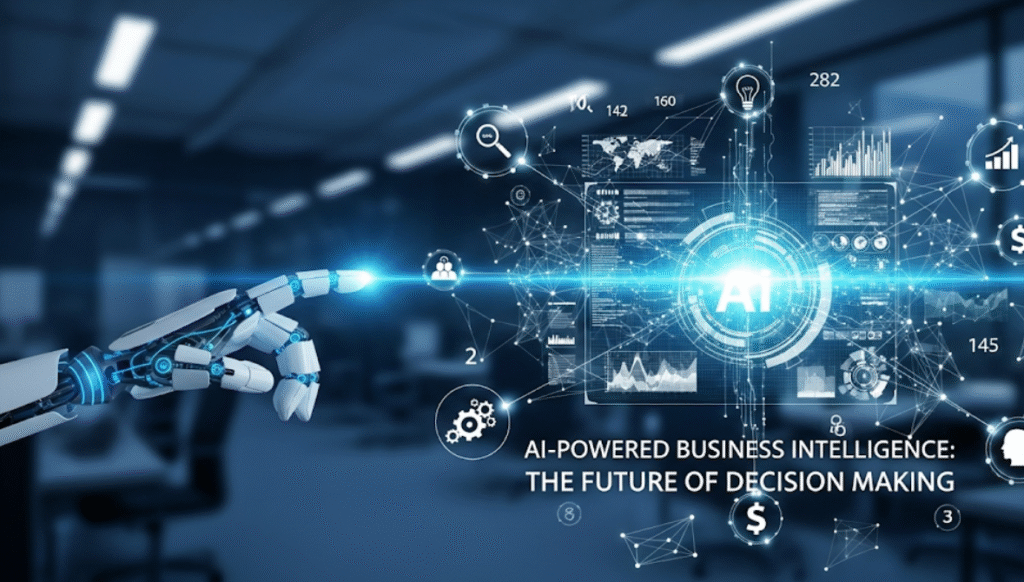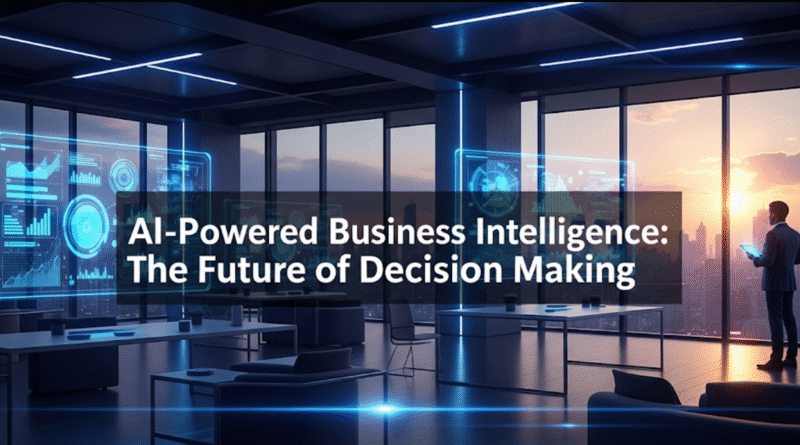AI-Powered Business Intelligence: The Future of Decision Making
In the current dynamic business scenario, quick and intelligent decision-making is what separates successful companies from unsuccessful ones. Companies are generating data from their websites, social media platforms, customer feedback, sales reports, and there seems to be no end in sight. However, the problem is not with the amount of information but what to do with all of it.
This is where artificial intelligence is on the cusp of a business intelligence revolution. AI-powered business intelligence immediately transforms raw data into actionable insight to assist executives in making superior decisions more quickly than ever before. This means no more waiting weeks to get answers from reports and spreadsheets; it can be used to run your business with solutions to complex questions about your operations, clients, or industry course changes just one second away.
This shift, from traditional business intelligence to the next generation of AI-driven business intelligence, is one of the most significant changes organizations are making across the world. With it, they can make rapid, data-driven decisions that significantly outdeliver their rivals. Without it, they struggle to maintain pace with the post-pandemic environment.
What is Different with AI-Powered Business Intelligence?
Traditional business intelligence systems necessitate the intervention of a squad of professional analysts to create studies individually. An important point is that those reports can only offer pre-set answers to pre-set questions. In this way, the effort to understand a new happening or resolve an unforeseen problem can take days or weeks in order to make a report from scratch.
Artificial intelligence-powered business intelligence is loads superior to it. First and foremost, they can take in vast amounts of data without any human interference to function. Secondly, it can detect obscure patterns or patterns that people would never discover or notice. Thirdly, it can predict future developments based on course history and current realities. Finally, all findings can be revised in real-time as they continue to expand with new data. New questions don’t require new tailored reports, and operate in the real-time surrounding can be resolved now.
Real-Time Data Processing Power
Speed is perhaps the biggest benefit to AI in business intelligence. Artificial intelligence, on the other hand, processes that data in mere seconds; where traditional systems would take hours to process the monthly sales. That means businesses can see problems and opportunities as they occur, not weeks later when it is too late to do anything about them.
A retail company using AI-powered business intelligence may notice that sales of winter coats are falling faster than expected in some regions—for instance. Managers will know that right away, and before they do become stock-heavy, they can alter their inventory levels or run promotions that hit lower-than-average performance.
Pattern Recognition Beyond Human Capability
We can find the obvious patterns (humans are great at it), where AI thrives is identifying subtle associations spanning complex data streams. For example, an AI system might find that customers who purchase particular items in the same transaction are 40 percent more likely to make another purchase within 30 days. For this reason, there is an immense potential in using such insight to enhance revenue-generating marketing at no small scale.
The same applies to pattern recognition capabilities including:
- Customer behavior analysis
- Market trend identification
- Operational efficiency improvements
- Risk assessment and fraud detection
- Supply chain optimization
Key Benefits Transforming Modern Businesses
The implementation of AI-powered business intelligence has allowed companies to improve significantly in all aspects of their operations. But that global lens doesn’t just reveal cost savings, it also opens up brand-new opportunities for growth and competitive advantage.
Faster Decision Making
In a normal business context, crucial decisions sometimes are postponed while reports are prepared and data gathered. AI removes these bottlenecks through instant availability of relevant information. Like when people in the organization ask complex questions and get immediate, correct answers so they can act on stuff more quickly because used to take them months to answer the same question to find that budgets were gone or too late for them to take said action.
Greater Precision and Lesser Human Mistake
Human mistakes in manual analysis occur when analysts can misinterpret the numbers, use previous information or leave out important things. Because, after all, AI systems never fatigue and they never have off days or miscalculations. They can promise that they will use the same analysis standards for every data set processed through them.
Cost Reduction Through Automation
By automating repeated data analysis work, enterprises could shift their human resources to broader-scale tasks (such as strategic insights). Analysts can allocate 80% of their time to patterns and actual strategies instead of 80% being reserved for data collection and organizing.
Enhanced Competitive Intelligence
AI watches competitor activity, market trends, and customer sentiment 24/7, in multiple channels at a time. With an enhanced market intelligence like this, a business can anticipate opportunities and threats well before everyone else does, thereby stealing a march over competition.
Essential Technologies Driving the Revolution
Multiple key technologies collaborate together to enable AI-powered business intelligence. The former is what one normally would call the data pool; it takes raw data and processes it into actionable insights.
Machine Learning Algorithms
Intelligent business analytics are built on top of machine learning. They use historical data to predict new outcomes. This is the backbone of machine-learning algorithms that learn from past responses to forecast future ones. The larger amount of data they process, the more accurately predictions will be made.
The most common business intelligence use cases for machine learning are:
- Predictive analytics for sales forecasting
- Classification algorithms for customer segmentation
- Abnormal pattern detection (abnormal episode detection)
- Clustering techniques for market analysis
- Regression models for trend analysis
Natural Language Processing
It does this by enabling business users to ask questions instead of having to type in difficult queries that only database administrators can create. Managers can then ask questions like: “which products have the highest profit margins last quarter?” and get immediate answers.
The level at which this technology aims to put the power of data in the hands of all is — any employee from any organization can have access to tools that help them make informed decisions while not depending on technical specialists for that.
Cloud Computing Infrastructure
Cloud platforms deliver the level of computing power required to process such vast amounts of data at that speed. Plus they allow for high scalability so businesses can easily manage growing data without investing in costly hardware infrastructure.
There are a few advantages delivered by cloud-based AI solutions:
| Benefit | Description |
|---|---|
| Scalability | Autoscaling based on data volume |
| Cost Efficiency | Pay-for-what-you-use data analytics |
| Accessibility | Insights anywhere with internet connection |
| Security | Enterprise-grade security safeguards and ongoing updates |
| Integration | Easy integration with your enterprise solutions |
Data Visualization and Dashboards
Contemporary AI systems visualize nuanced information through intuitive displays. Interactive dashboards enable users to view data from different perspectives, drill down into specifics, and make discoveries within teams.
Advanced visualization features include:
- Real-time updating charts and graphs
- Interactive filtering and sorting options
- Mobile-responsive design for on-the-go access
- User role-based configurations for specific roles
- Real-time notifications of key developments
Real-World Applications Across Industries
The business intelligence enabled by AI is radically changing many industries using it in their own ways, from investment advising and healthcare to retail and manufacturing.
Retail and E-commerce
Customers, AI is being used to analyze the consumer behavior by online retailers so that they can optimize their prices and manage various other processes related to order fulfillment & inventory. These systems can identify which products are most popular at any given time of the year, who will be ready to buy your high-ticket items right now and what elements together will increase your shopping averages.
Key applications include:
- Dynamic pricing (adjusts by demand, competition etc.)
- Product recommendations per customer
- Efficiency in setting up inventory to reduce waste and stock-outs
- Customer Lifetime Value (CLV) for niche-specific marketing
- Fraud detection in payment processing
Healthcare Systems
Artificial intelligence business intelligence in healthcare allows organizations to improve patient outcomes, reduce costs, and optimize resource allocation. They can predict disease outbreaks, identify high-risk patients and improve hospital operations.
Financial Services
Banks and Financial institutions use AI for evaluating the risk of customers, identifying fraudulent transactions as well as creating personalized advice to its users. They are using the technology to comply with regulations and increase customer satisfaction and profits.
Manufacturing Operations
AI-driven analytics enable manufacturers to optimize production processes, forecast equipment failures, and enhance quality control. These systems can also help in identifying each production line blockage and thus suggest the necessary changes helping them to perform better.
Implementation Strategies for Success
AI Business Intelligence is all about doing proper research and implementation. The full benefits of these powerful tools are often unrealized because organizations rush into adoption without proper preparation.
Start with Clear Business Objectives
Companies have to capture some business problems before picking AI tools. Common objectives include:
- Reducing customer churn rates
- Improving sales forecasting accuracy
- Optimizing marketing campaign performance
- Streamlining operational processes
- Enhancing customer experience
Ensure Data Quality and Integration
AI based systems are good to the extent of data at their disposal. This requires organizations to spend both time and resources on cleaning up their data and synchronizing data from several sources. This often involves:
- Quality issues auditing in data
- Data format standardization among systems
- Integration of disparate data sources
- Governance policies for data management
- Ongoing quality maintenance
Build the Right Team
To get AI ‘right,’ combine technical expertise and business acumen. Key team members should include:
- Data scientists savvy in AI algorithms / statistical methods
- Business analysts who convert insights to strategy
- Technical infrastructure managers in IT
- Subject matter experts familiar with certain business problems
- Change management experts who assist businesses with rolling out updated processes
Choose Scalable Solutions
As data oriented organizations grow, the needs for data handling and its processing systems also grow. Companies need to ensure they select systems that not only meet existing needs but can be expanded to process more data and use additional cases.

Overcoming Common Challenges
In addition to the significant benefits already identified, organizations face several other challenges regarding the given technology.
Secure Data
With the entry into force of laws protecting personal data and the increasing likelihood of loss of such data, organizations should ensure that their AI systems comply with new laws and at the same time ensure data security and privacy through access controls, encryption, and audit trails.
Integration and Adoption
Companies often face challenges when integrating new technologies into existing systems. They have to upgrade old systems which need replacement. It is to be considered that it is difficult for a person to use techniques if no one has taught him. It is essential to provide personnel with the necessary training.
Managing Expectations
AI is not magic – it is powerful, but organizations should not expect it to magically solve all their problems. Business processes should be changed gradually with continuous improvement by trial and error, not in the first implementation.
The Future Landscape of Intelligent Decision Making
AI is evolving at a rapid pace and, therefore, there is a list of several developments that are worth noting. First of all, conversational analytics – the user will not describe the dataset he needs in detail, but will tell the system what he needs and the system itself will specify a request.
Automated Insights Generation
Soon, AI systems will automatically detect significant trends and outliers without any intervention from humans. AI-driven tools will then automatically produce insights and suggestions to spur decision-makers into action as opportunities and threats take shape.
Edge Computing Integration
The development point of AI analysis when more hardware devices goes online. This path of edge computing will allow for instant decision making in scenarios where fractions of a second count.
Ethical AI and Explainable Decisions
With AI systems becoming smarter, there’s an increasing focus on ensuring they make fair and unbiased decisions. Next systems will come with their justifications and that the users can understand why these insights.
Frequently Asked Questions
Q: How much does AI-powered BI cost to implement?
A: Pricing varies greatly depending on the size of your organization, how complex your data is and what you need from us. While small businesses could shell out between $10,000 to $50,000 per year for cloud-based solutions and large enterprises might sink millions into fully-rounded systems. The technology is subscription based and scales with your volume using multiple different providers.
Q: What is the timeline for AI business intelligence implementation and results visibility?
A: The direct results become apparent for most organizations within 3-6 months following the implementation. Normally, however, the full value only arrives after 12-18 months when your teams have got to grips with the tools in earnest and you’ve done work improving data quality. Those quick wins are usually in the form of automating reports and dashboards you are running manually now.
Q: Do we need to hire data scientists in order to use AI business intelligence tools?
A: Not necessarily. Many of the newest AI business intelligence platforms are user friendly for business users without technical backgrounds. The caveat, however, is that you need at least one person who can analyze data to leverage data analytics tools and apply them correctly.
Q: Will AI Business Intelligence work with our existing software systems?
A: The bulk of this integration typically involves top business software — like CRM systems, ERP platforms, digital marketing solutions, and databases — as many contemporary AI BI platforms will offer in-depth integration capacities between one another. The complexity of the integration will depend on your particular systems and data requirements.
Q: What happens when the AI predicts incorrectly or gives the wrong recommendation?
A: The first rule of AI systems is that they are there to support, not to decide on their own. Best practice also involves an element of human oversight, validation on the model which can be safely done in production, and reputable processes for prediction errors. Though, in general as these systems process more data the accuracy of AI model improves (and thus would have better scores here).
Q: Is our information secure in cloud-based AI Business Intelligence Solutions?
A: Enterprise-grade security: Encrypted, access control. Security audit by providers. But organizations should consider security policy and may decide on a hybrid or on-premises solution for very particular sensitive data.
Conclusion: Embracing the Intelligent Future
The step forward that AI-powered business intelligence represents is in a way much more than another technology upgrade; it’s a paradigm change of how companies see and react to its world. Companies that embrace this change can make better and faster decisions, take new opportunities and be ahead of the competition.
The technology has come of age — moving from the laboratory into real-world measures that gain returns. Organizations in every industry, from a small startup to a global corporation are realizing how AI-driven insights offer an edge in today’s data-centric marketplace.
AI business intelligence does not have to be perfect in the beginning. The best success using AI / ML is incremental — starting with well-defined, achievable goals, and gradually increasing the scope as teams become more comfortable with it. The trick is to start that journey right now, while learning and adapting along the way.
What is certain, however, is that those organizations that best deploy AI for business intelligence will end up better-adapted to take on the many challenges ahead for them in the future and discover new sources of value as well. There is no dispute like should this technology be introduced, but when can you even start changing your mindset!
The next generation of business decisions will be smart, autonomous and immensely impactful. The companies that adopt AI-based Business intelligence in this very moment may lead the market trends of tomorrow, those who wait could end up scrambling to position themselves ahead in a more competitive horizon.

